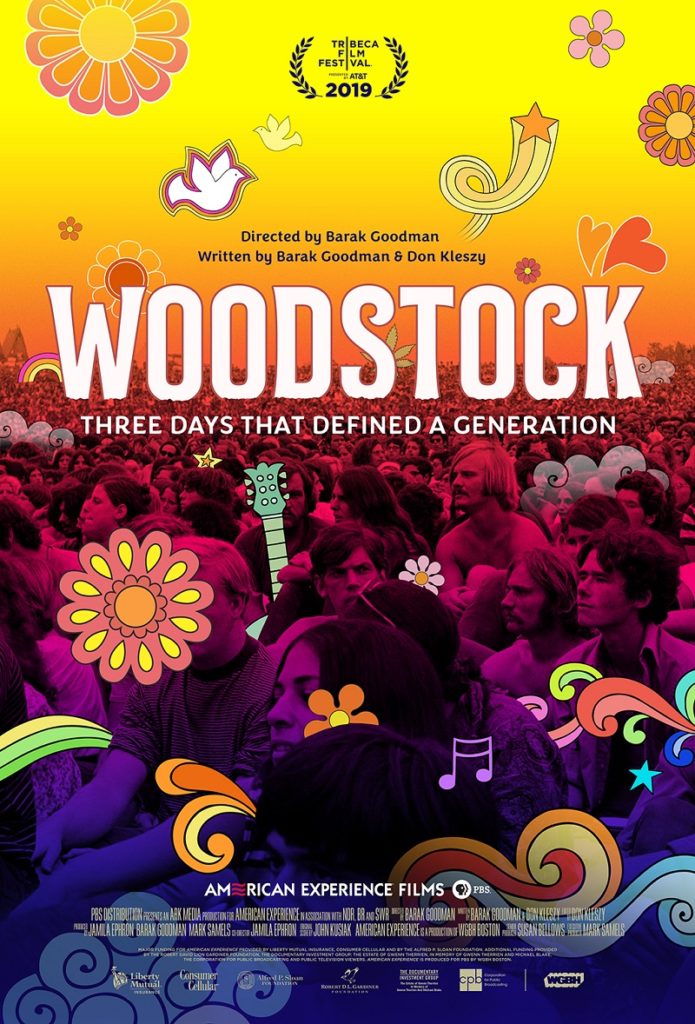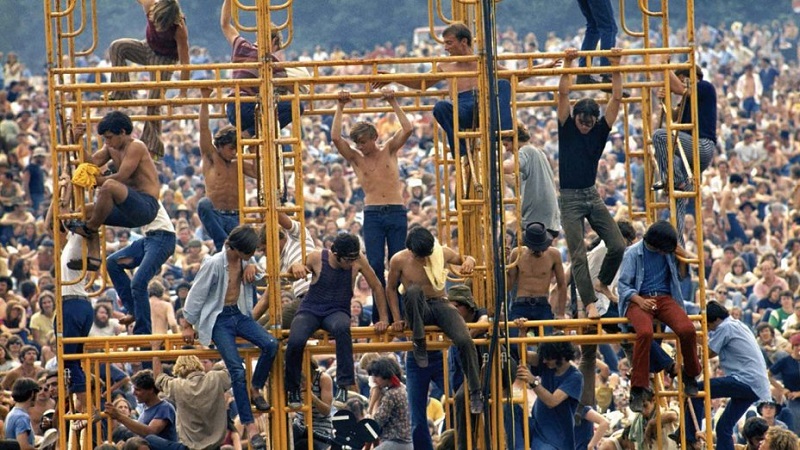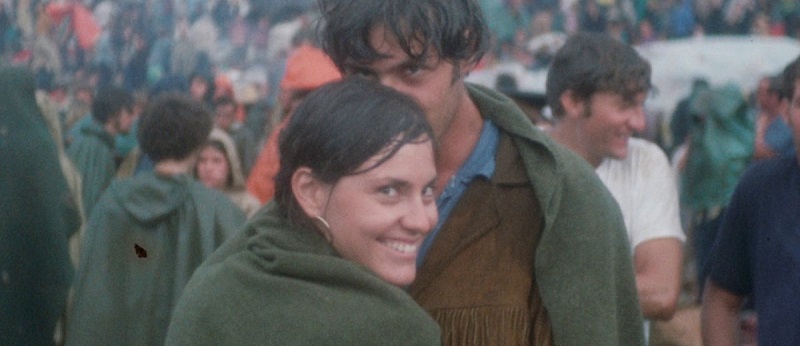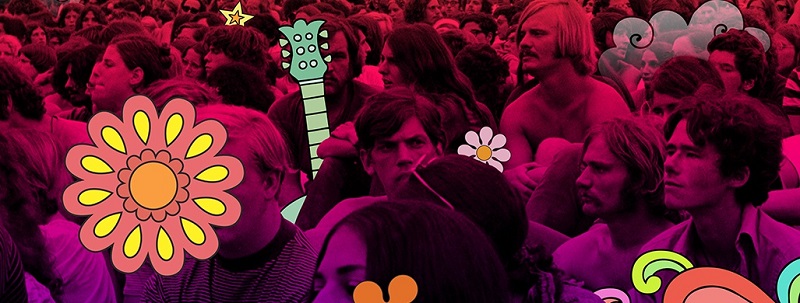With the iconic documentary that is Woodstock, one might wonder why anyone would need to head down that peace and love road again. After all, the 1970 flick won the Oscar for Best Documentary Feature and its legendary status capturing the once-in-a-lifetime music festival has been more than cemented with the passage of time and generations who have inhaled its brilliance. That all being said, there’s an avenue that Woodstock: Three Days That Defined a Generation takes that had us cheering these documentarians with their enthralling, entertaining and above all else, enlightening and unique look at “An Aquarian Exposition: 3 Days of Peace & Music” that is extraordinary in every sense of the word.

Directors Barak Goodman and Jamila Ephron tackle a scope on the legendary event that is truly fascinating and unique. They focus, at first, on the four young men (entrepreneurs, really) who saw the budding musical festival entity as something that could make them a pretty penny. They zero in on a site (upstate New York) and start soliciting bands (The Who, Jimi Hendrix, The Grateful Dead all say yes) and commence selling tickets (which was going quite well). Then, everything that can go wrong, does.
First, the townsfolk who live in the original locale back out, fearing everything that a fest that could bring in 100,000 people would do to their community. The organizers find Woodstock and even a farmer (Max Yasgur), who is willing to let them use his vast property for the event. That doesn’t mean his neighbors are going to let this happen. They do everything they can to make it a challenge … and it is, beyond what anyone could have foreseen.
Just a hint of what organizers were dealing with: Due to the last minute site change, construction on the stage and lighting and audio systems was majorly last minute. One of the things that never was gotten to was the erecting of a fence to keep people organized in attending … remember, these businessmen were seeking to make a mint. Instead, with no fence erected, Woodstock became a massive, free concert. Word got out that it was free and what seemed like an entire generation descended on the sleepy little upstate New York community. Traffic snarled to a stop. People just got out of their cars and walked. By all accounts, the attendance swelled to between 400,000 to 500,000 people. No one was prepared for that. in terms of food, water, medical staff and even bathrooms. Due to the roads being blocked by countless hippies leaving their cars in the middle of the road, all those musicians, could get to the stage! Helicopters had to be employed and that takes time.
All of this is masterfully chronicled in Woodstock: Three Days that Defined a Generation. See, it’s not so much about the music, which the first doc focused on with outstanding results. There is still music at the heart of this doc, but it is not the thing that is spotlighted. It’s stunning in how it is used. For example, you have those hundreds of thousands of folks awaiting some music, heck, even a note or two would be nice. But musicians can’t even get there … yet. Richie Havens was there, but no one from his band had arrived yet. Organizers begged him to go on, just to get this thing going. He triumphantly rocked through a two-hour set and ran out of music. He made a song up on the spot called Freedom and it became an instant rallying cry for not only everyone at the festival but the generation seeking to change the world. See, fate presented everyone involved with an enormous hill to overcome and things just came together. It was like the universe wanted this event to work and serve as a microcosm of how society should operate at its highest and most personal levels. That is the mission statement of the filmmakers here and through what we see happening as the music fest progresses, it could not be a better model for humanity as a whole.
It could have been a massive disaster. There could have been serious human cost, deaths and other physical prices to be paid. But when all was said and done, no one died. There was no where near enough food and when they ran out of food on day two, the staunchly Republican community rallied and emptied their cupboards, fridges and cabinets and a half a million kids got the nourishment they required. Water came via the National Guard and instead of being sent in to disperse this massive crowd, as New York Governor Nelson Rockefeller initially wanted, they provided helicopters to bring in more medical staff and supplies for the masses and again, people pulled together, and this thing worked.

A massive rainstorm notoriously descended on the crowd. That could have been another disaster, but it—instead—became part of the Woodstock lore. People played in the massive mud and embraced the challenges, instead of suffering from them. That is one of the greatest achievements of Goodman and Ephron’s movie is painting a picture of how people can achieve incredible things when we work together, regardless of our political affiliation or stance on issues (such as the Vietnam war). There was a great speech that Yasgur gave on the second day of the fest (just before Joe Cocker took the stage) that Ephron and Goodman feature in its entirety that is just priceless. He salutes the crowd and says that the world is watching and that these half a million youths are giving the planet a lesson in peace, love, harmony and the idea of a collective being more important than the individual. It’s a stunning moment that personifies the takeaway from this entire film. We can only hope to carry ourselves in a manner that everyone who was in Woodstock (festival goer, workers, local residents and even our elected leaders) does and if we did, the film suggests, the entire world would be a better place.
Woodstock: Three Days that Defined a Generation earns its moniker. Sure, it was a terrific 72-hour period for the best bands and artists of the day putting on musical sets that transcend their respective genres. The lesson learned from what happened over that time period in the small upstate New York hamlet is that the human race—at its core—is good, and as generous as it is gregarious. So many things had to happen, altruistically, for this thing to be successful. They all did. Think about that. Do you think that that many people could gather in 2019, without adequate food, water and even medical access, and there would not be casualties? Not in the least.
This documentary is as much a love letter to that generation of the film’s title as it is a showcase of what happened—beyond the music—at Woodstock 50 years ago this August. For anyone who was there or is a member of that titular generation, do not miss this film. For the rest of us, do not miss this film because it is an enormous slice of inspiration and hope. I still believe in the ideals of the 60s that somehow got lost in the annuls of time.

Witnessing Ephron and Goodman’s stellar cinematic gem leaves me believing that even though our country could not be more divided currently, at our core we are still the country that lived through those fateful days in 1969 in Woodstock and emerged stronger because of it. That microcosm of America is what we should be running towards and not running from. Americans are a generous people, it’s just that certain leaders hijack our lesser selves for the purpose of dividing us to push personal agendas. Woodstock reminds us that at the heart of our nation is a people who can rally together when we aspire to think beyond our four walls and embrace the core elements of what can potentially make our country the greatest on earth.Grade: A

